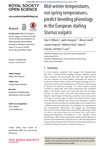Mid winter temperatures, not spring temperatures, predict breeding phenology in the European starling Sturnus vulgaris
| dc.contributor.author | Williams, Tony D. | en_US |
| dc.contributor.author | Bourgeon, Sophie | en_US |
| dc.contributor.author | Cornell, Allison | en_US |
| dc.date.accessioned | 2016-07-18T06:49:12Z | |
| dc.date.available | 2016-07-18T06:49:12Z | |
| dc.date.issued | 2015 | en_US |
| dc.identifier.other | HPU4160456 | en_US |
| dc.identifier.uri | https://lib.hpu.edu.vn/handle/123456789/22301 | en_US |
| dc.description.abstract | In many species, empirical data suggest that temperatures less than 1 month before breeding strongly influence laying date, consistent with predictions that short lag times between cue and response are more reliable, decreasing the chance of mismatch with prey. Here we show in European starlings (Sturnus vulgaris) that mid-winter temperatureca50–90 days before laying (8 January–22 February) strongly (r2=0.89) predicts annual variation in laying date. | en_US |
| dc.format.extent | 9 p. | en_US |
| dc.format.mimetype | application/pdf | en_US |
| dc.language.iso | en | en_US |
| dc.subject | Biology | en_US |
| dc.subject | Ecology | en_US |
| dc.subject | Evolution | en_US |
| dc.subject | Physiology | en_US |
| dc.subject | Temperature | en_US |
| dc.subject | Breeding phenology | en_US |
| dc.subject | Tipulids | en_US |
| dc.title | Mid winter temperatures, not spring temperatures, predict breeding phenology in the European starling Sturnus vulgaris | en_US |
| dc.type | Article | en_US |
| dc.size | 404KB | en_US |
| dc.department | Education | en_US |
Files in this item
This item appears in the following Collection(s)
-
Education [806]

